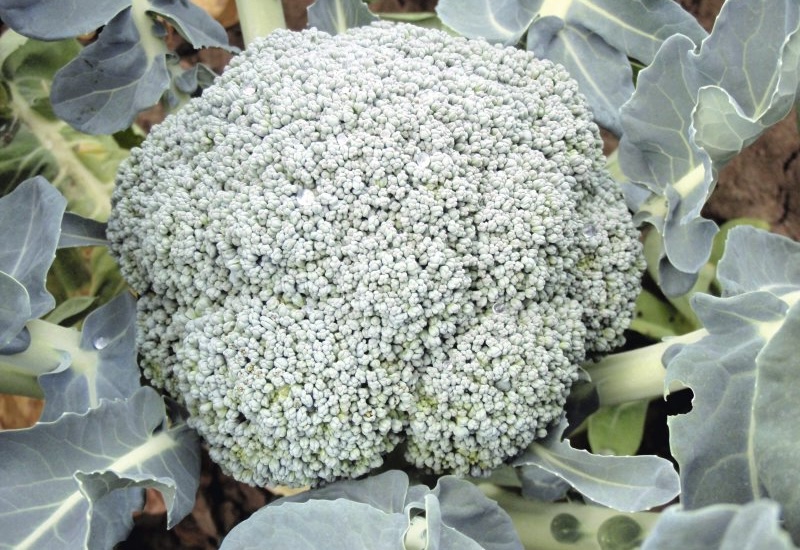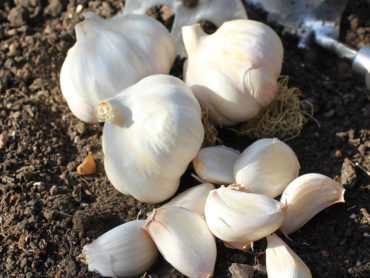Broccoli is one of the UK’s most popular vegetables, providing repeated clusters of purple or white spears over several months. While some varieties are ready to harvest from late summer, this nutritious vegetable is traditionally grown for winter and early spring crops. Whether you want to grow tender spears of sprouting broccoli or large heads of calabrese, here are some top tips from experienced allotmenteer Lee Senior.
Browse our full range of broccoli seeds for inspiration.
What are the best varieties of broccoli to grow?
Purple sprouting broccoli is widely grown by veg gardeners and allotment holders for its tasty nutritional spears. It’s usually harvested in autumn, or between late February and the end of April.
Calabrese is from the same family, but produces good-sized, tight, green heads that are slightly milder than sprouting varieties. It’s usually harvested from mid-summer to early winter. Here are some of my favourites:
- My favourite green-coloured broccoli is F1 ‘Stromboli’. It produces reliable, tight florets and can be sown in both spring and autumn, greatly lengthening the cropping season. Early sowings made in spring are ready to harvest in June, while autumn-sown plants are ready for harvesting during March and April.
- If it’s speed you’re after, then Broccoli F1 ‘Gemini’ can be ready in just under 90 days given favourable conditions. This variety also has good disease resistance and grows very good sized florets. It’s a popular summer-harvesting broccoli.
- Broccoli ‘Purple Sprouting’ is an ultra-dependable variety that has been around for what feels like forever. It’s ready to harvest from late-February to the end of April, from sowings made the previous May. It’s the first variety I ever grew as a young student, and cropped for 8-10 weeks which set a high benchmark for all others!
- A packet of ‘Purple Sprouting Continuity Mix’ contains two varieties that provide a harvest both in spring and autumn. This is a great choice for anyone wanting to harvest purple broccoli over a longer period.
- If you fancy purple broccoli spears in the warmer summer months try Broccoli ‘Summer Purple’. This variety is ready to harvest in late summer (from late July to the end of September) rather than the traditional late winter period.
- For something completely different, broccoli makes a tasty and nutritious microgreen crop and can be grown all year round on a windowsill. Try ‘Broccoli Green Sprouting’ which is ready in 10-21 days.
How and when to sow broccoli seeds

This variety throws out multiple small spears once the main head is harvested
Image: Broccoli ‘Blue Finn’ F1 seeds from Suttons
I tend to sow broccoli seeds successionally from early March through to the end of May to ensure the cropping period is as long as possible.
Early March sowings can be made under glass in a cold greenhouse or on a windowsill to aid germination. Minimum temperatures of 12C are required and germination takes 7-10 days on average. Sow the seed in compost in a seed tray, or in modules, at a depth of 15mm. Cover the seed with compost or vermiculite. Pot the seedlings on and then transplant them outdoors around 4-6 weeks later in the usual way, after acclimatising the young plants to outdoor conditions. Take care not to expose the seedlings to too much direct sunlight or intense heat while they’re developing, as this will set them back, and sometimes render them useless.
Later sowings, from the end of April onwards, can be made outdoors in a prepared seedbed once the soil warms up. Sow the seed a little deeper than indoors, at about 20mm, and cover with compost. Pre-water the seed drills if conditions are dry.
It’s also possible to directly sow your broccoli seeds outdoors where they are to grow to maturity. Weaker specimens can be thinned out leaving the strongest plants to grow on without disturbance. You’ll need to protect outdoor grown seeds from slugs, but this method means the plants don’t need any acclimatising to outdoors conditions. The seedlings will develop a little slower and more steadily than those under glass, but this isn’t necessarily a bad thing.
Where to plant broccoli

Purple sprouting broccoli produces succulent purple spears
Image: Broccoli ‘Purple Sprouting’ seeds from Suttons
Winter-cropping broccoli is a hardy, long-term crop that occupies space in your bed for up to ten months. Choose the location carefully as the land will be in use for a significant period of time. Late-summer/autumn-cropping broccoli and calabrese aren’t in the ground for anything like as long as winter varieties. These plants occupy the ground for just five or six months.
Winter varieties can reach a height of around 90cms (3ft) and a similar width too! With this in mind, do try to avoid windy locations as the plants can become top heavy and even get blown over. Staking can sometimes be necessary to help the plants stay upright.
Broccoli enjoys some sun, although the plants will tolerate light shade for part of the day. Too much intense heat isn’t desirable, as it puts the plants under stress.
Raised beds are suitable for growing broccoli, provided there’s sufficient organic matter and moisture in the soil. Wherever you decide to plant your crop, it’s important to rid the soil of all perennial weeds in advance.
How to care for broccoli

‘Stromboli’ seeds can be sown in the spring or autumn months
Image: Broccoli F1 ‘Stromboli’ seeds from Suttons
Growing broccoli isn’t particularly difficult. It likes to be grown in soil containing plenty of well-rotted organic matter, and this will produce stronger plants and a heavier crop. Moisture-retentive soil with a PH reading of around 6.5 to 7 is ideal. Give newly-planted broccoli plenty of water, and also during drier periods of weather. Watering helps the plants to grow, but also deters aphids which can strike in hot weather if the plants are under stress due to dry roots.
As part of the brassica clan, broccoli can be subject to attacks from a number of pests so covering with netting or mesh is essential. Anti-butterfly netting is best, as it protects your plants from pigeons and the cabbage white butterfly. If you do spot any caterpillar eggs on the leaves, quickly deal with them using the finger and thumb method (not for the squeamish!)
Slugs and snails are another threat to the plants, particularly while they’re young and at the seedling stage. The threat increases during wet weather so use your usual method to deter them.
Cabbage root flies are another pest to look out for. It’s a good idea to place a brassica/cabbage collar around young plants when planting out to prevent the larvae from eating the roots of your brassicas.
If your allotment or garden suffers from clubroot, add lime to the soil to raise the PH level. Plants that succumb to clubroot become stunted, sickly looking and wilt, even during wet weather.
When to harvest broccoli

‘Gemini F1’ is ready to harvest in just 80 days
Image: Broccoli ‘Gemini F1’ seeds from Suttons
Calabrese should be harvested when the largest central head reaches a good size. The trick is to always harvest this head first, as it kick-starts the production of secondary, smaller spears from side shoots. These will be ready to harvest within 2-3 weeks for a crop. Purple broccoli, in particular, produces several flushes of new spears this way.
When harvesting, cut your broccoli with a knife. If you don’t happen to have one on you, then it’s usually possible to snap the florets with your finger and thumb. I’ve even been known to use secateurs! The most important thing to remember is to harvest the head or spears before there are any signs of flowering. Any signs of yellow on the heads or spears, often on the outside first, means flowering is imminent, and this is your cue to harvest quickly.
Picking broccoli at its absolute best requires some experience, but this will come with practice. Check on the developing spears every few days once they start to form, as they can soon start to turn yellow and flower, especially when the weather is warm.
We hope these tips will help you to successfully grow your own broccoli at home. Find more of Lee’s practical, hands-on, vegetable growing advice over at his monthly allotment pages. You can also follow Lee on Instagram: @lee_senior_gardening.
Lead Image: Broccoli (Sprouting) ‘Summer Purple’ seeds from Suttons



